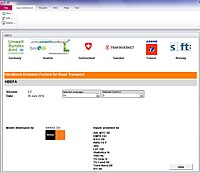
Photo from wikipedia
Urban public transport is a very complex system, and with the development of urbanization, there are many new urban traffic characteristics. Making bus routes and scheduling strategies more efficient, scientific… Click to show full abstract
Urban public transport is a very complex system, and with the development of urbanization, there are many new urban traffic characteristics. Making bus routes and scheduling strategies more efficient, scientific and accurate has a positive impact on the actual operation of public transport. To solve the urban public transport line design problem, this paper describes the implicit law of the characteristics of public transport travel from a deep perspective and analyzes the forms, influencing factors and existing problems of bus dispatching. By establishing a multiobjective public transport dispatching optimization model, starting from bus companies, passengers and government departments, public transportation operating costs comprehensively consider the interests of various parties and finally realize the optimization objective of minimizing fixed costs, fuel costs, carbon emission costs and time window penalty costs. The objective function is set reasonably, and the generation and optimization method of the initial line set in the public transport line design problem is improved; suitable constraint conditions and evaluation indicators are considered. This paper attempts to control the overall length of the bus line on the premise of fully meeting the travel needs of passengers. By solving the multiobjective problem on the same network and comparing different multiobjective optimization algorithms, the effectiveness of the method is evaluated. Additionally, an improved multiobjective adaptive particle swarm optimization (MOAPSO) is proposed, which has the characteristics of faster convergence, higher efficiency and low computational complexity. The simulation experimental results show that the proposed algorithm in this paper can obtain a better Pareto optimal solution set and can effectively solve the multiobjective model. The departure interval conforms to the passenger flow distribution, which can effectively reduce costs and improve the travel service quality of passengers on a large-scale network.
Journal Title: IEEE Transactions on Intelligent Transportation Systems
Year Published: 2022
Link to full text (if available)
Share on Social Media: Sign Up to like & get
recommendations!